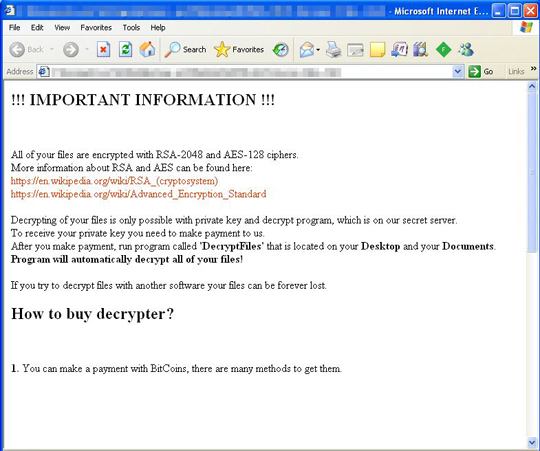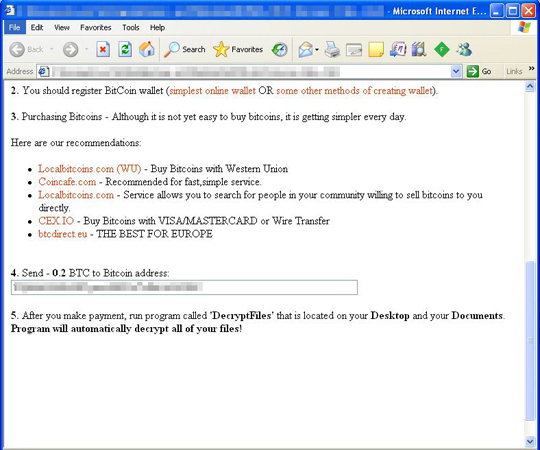RANSOM_MABORO.A
Ransom.Marlboro (Malwarebytes), W32/Filecoder_Marlboro.A!tr (Fortinet)
Windows


Threat Type: Trojan
Destructiveness: No
Encrypted: No
In the wild: Yes
OVERVIEW
However, as of this writing, the said sites are inaccessible.
TECHNICAL DETAILS
693,760 bytes
EXE
Yes
12 Jan 2017
Connects to URLs/IPs, Encrypts files, Displays message/message boxes
Installation
This Trojan drops the following files:
- {folder of encrypted files}\_HELP_Recover_Files_.html - ransom note
- %User Profile%\SoftwareInfo.dat
(Note: %User Profile% is the current user's profile folder, which is usually C:\Documents and Settings\{user name} on Windows 2000, XP, and Server 2003, or C:\Users\{user name} on Windows Vista and 7.)
Other Details
This Trojan connects to the following possibly malicious URL:
- http://{BLOCKED}t.{BLOCKED}b.com/
It encrypts files with the following extensions:
- .mid
- .wma
- .flv
- .mkv
- .mov
- .avi
- .asf
- .mpeg
- .vob
- .mpg
- .wmv
- .fla
- .swf
- .wav
- .mp3
- .qcow2
- .vdi
- .vmdk
- .vmx
- .gpg
- .aes
- .ARC
- .PAQ
- .tar
- .bz2
- .tbk
- .bak
- .tar
- .tgz
- .rar
- .zip
- .djv
- .djvu
- .svg
- .bmp
- .png
- .gif
- .raw
- .cgm
- .jpeg
- .jpg
- .tif
- .tiff
- .NEF
- .psd
- .cmd
- .bat
- .class
- .jar
- .java
- .asp
- .aspx
- .brd
- .sch
- .dch
- .dip
- .vbs
- .asm
- .pas
- .cpp
- .php
- .ldf
- .mdf
- .ibd
- .MYI
- .MYD
- .frm
- .odb
- .dbf
- .mdb
- .sql
- .SQLITEDB
- .SQLITE3
- .asc
- .lay6
- .lay
- .ms11
- .sldm
- .sldx
- .ppsm
- .ppsx
- .ppam
- .docb
- .mml
- .sxm
- .otg
- .odg
- .uop
- .potx
- .potm
- .pptx
- .pptm
- .std
- .sxd
- .pot
- .pps
- .sti
- .sxi
- .otp
- .odp
- .wks
- .xltx
- .xltm
- .xlsx
- .xlsm
- .xlsb
- .slk
- .xlw
- .xlt
- .xlm
- .xlc
- .dif
- .stc
- .sxc
- .ots
- .ods
- .hwp
- .dotm
- .dotx
- .docm
- .docx
- .DOT
- .max
- .xml
- .txt
- .CSV
- .uot
- .RTF
- .XLS
- .PPT
- .stw
- .sxw
- .ott
- .odt
- .DOC
- .pem
- .csr
- .crt
- .key
- .dat
It renames encrypted files using the following names:
- {file name}.{file extension}.oops
It does the following:
- It deletes all shadow copies by executing the following command:
- /C vssadmin.exe Delete Shadows /All /Quiet
- It drops the following ransom notes:


However, as of this writing, the said sites are inaccessible.
NOTES:
This ransomware encrypts files in the following locations:
- %Desktop%
- %User Profile%\Documents
- C:\Documents and Settings\All Users\Documents\My Music - Windows XP and older
- C:\Documents and Settings\All Users\Documents\My Pictures - Windows XP and older
- C:\Users\Public\Music - Windows 7 and later
- C:\Users\Public\Pictures - Windows 7 and later
- {Fixed Hard Disk Drives}
SOLUTION
9.800
13.152.05
12 Jan 2017
13.153.00
13 Jan 2017
Step 1
Before doing any scans, Windows XP, Windows Vista, and Windows 7 users must disable System Restore to allow full scanning of their computers.
Step 2
Note that not all files, folders, and registry keys and entries are installed on your computer during this malware's/spyware's/grayware's execution. This may be due to incomplete installation or other operating system conditions. If you do not find the same files/folders/registry information, please proceed to the next step.
Step 3
Restart in Safe Mode
Step 4
Search and delete this file
- %User Profile%\SoftwareInfo.dat
- {folder of encrypted files}\_HELP_Recover_Files_.html
Step 5
Restart in normal mode and scan your computer with your Trend Micro product for files detected as RANSOM_MABORO.A. If the detected files have already been cleaned, deleted, or quarantined by your Trend Micro product, no further step is required. You may opt to simply delete the quarantined files. Please check this Knowledge Base page for more information.
Step 6
Restore encrypted files from backup.
Did this description help? Tell us how we did.

